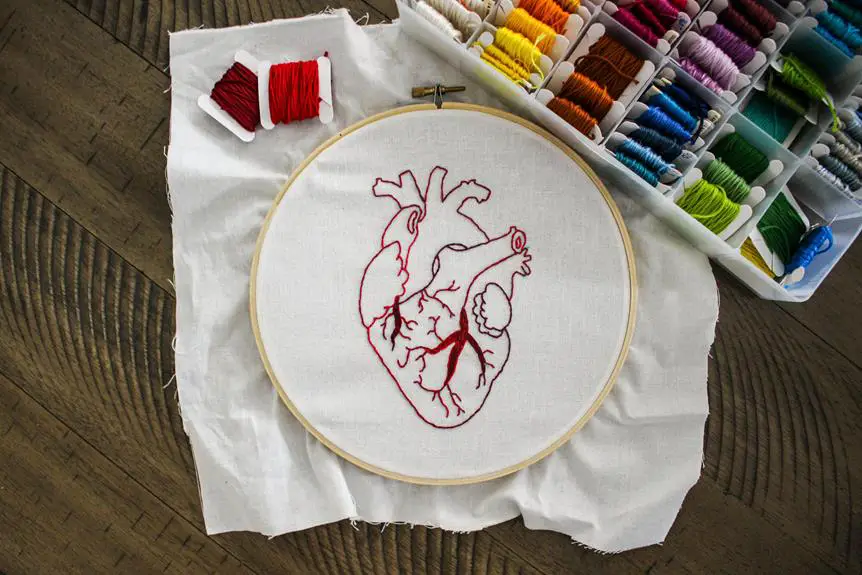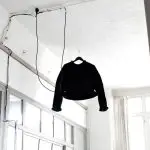Looking to master the art of embroidery? Selecting the right fabric is essential for achieving impeccable results. Delving into the world of embroidery, you'll find that certain fabrics lend themselves more favorably to the intricate dance of the embroidery thread.
From the timeless appeal of cotton and the natural elegance of linen to the opulent allure of silk and the plush texture of velvet, each fabric presents its own unique canvas for your embroidery endeavors. Understanding the nuances of these fabrics will empower you to elevate your embroidery creations to new heights.
Let's explore the best fabrics for embroidery thread and equip you with the knowledge to make informed and masterful choices for your next embroidery project.
Key Takeaways
- Cotton fabric and linen fabric are durable and provide a stable foundation for embroidery, making them ideal for intricate designs and various embroidery techniques.
- Aida cloth is a popular choice for cross-stitch and needlework due to its even weave, visible grid, and high thread count for finer details.
- Silk fabric has a smooth and luxurious texture, making it perfect for intricate details. It requires silk embroidery thread and fine embroidery needles for delicate fibers.
- Wool fabric offers versatility, warmth, and texture to designs, especially for techniques like crewelwork and needle felting. It provides a unique look and feel, making it suitable for creating textured and dimensional effects.
Cotton Fabric
When choosing a fabric for embroidery thread, your best option is cotton's durability and smooth texture. Cotton fabric is an excellent choice for various embroidery techniques due to its ability to hold stitches well and withstand the tension created by different embroidery styles. The natural fibers of cotton make it easier to work with, allowing for intricate designs and precise detailing. Its smooth surface provides a stable foundation for embroidery, ensuring that your stitches are even and consistent.
Cotton fabric is particularly suitable for techniques like satin stitch, French knots, and cross-stitch, where the fabric needs to support the embroidery without distorting the design. The durability of cotton also makes it ideal for items that will undergo regular use and washing, such as table linens, clothing, and home decor. Additionally, cotton's breathability and hypoallergenic properties make it a preferred choice for embroidery on items intended for skin contact.
Linen Fabric
When choosing fabrics for embroidery, linen is an excellent choice for delicate stitches due to its smooth and even weave.
The natural texture of linen also provides a unique dimension to the embroidered design, enhancing its overall aesthetic.
These qualities make linen a preferred fabric for creating intricate and detailed embroidery work.
Linen for Delicate Stitches
One of the best fabrics for delicate stitches is linen. Linen's smooth, even texture makes it ideal for intricate embroidery on silk, allowing for precise, fine stitching. The natural stiffness of linen provides stability, making it suitable for woolen embroidery techniques as well.
When working with delicate stitches, it's crucial to choose a fabric that can support the intricacy of the design without compromising the integrity of the fabric. Linen's ability to hold up under tension while maintaining its smooth surface makes it an excellent choice for delicate embroidery work.
Its strength and durability ensure that the fabric can withstand the demands of delicate stitches, making it a top choice for those seeking to master the art of embroidery on delicate fabrics.
Linen's Natural Texture
To achieve the best results in embroidery, start by selecting linen fabric for its natural texture, which provides stability and support for intricate stitching.
Linen's versatility as a fabric makes it suitable for a wide range of embroidery projects. The natural texture of linen fabric offers a slightly uneven surface, which allows the embroidery thread to catch and create a distinctive look.
This texture also provides a stable foundation for various embroidery techniques, such as counted thread embroidery or surface embroidery. Whether you're working on delicate floral patterns or complex geometric designs, linen's natural texture enhances the overall quality of the embroidery.
Its ability to hold stitches firmly without distorting the fabric makes it an ideal choice for mastering the art of embroidery.
Aida Cloth
When it comes to embroidery, Aida cloth is a popular choice for both cross-stitch and needlework. The even weave and visible grid of Aida make it easy to work with, especially for beginners.
Whether you're creating intricate designs or simple patterns, Aida cloth provides a stable and uniform base for your embroidery projects.
Aida for Cross-Stitch
When selecting Aida cloth for cross-stitch embroidering, you should choose a fabric with a higher thread count for finer details in your designs. A higher thread count means more stitches per inch, allowing for intricate and detailed cross-stitch patterns.
Here are three important factors to consider when choosing Aida cloth for cross-stitch:
- Thread Count: Opt for Aida cloth with a higher thread count, such as 14 or 16 count, for detailed and refined cross-stitch designs.
- Fabric Color: Select a fabric color that complements your cross-stitch pattern and enhances the overall aesthetic of your embroidery.
- Material Quality: Ensure that the Aida cloth is made of high-quality material to prevent fraying and maintain the integrity of your cross-stitch work.
Choosing the right Aida cloth is crucial for achieving professional-looking and visually appealing cross-stitch embroidery.
Aida for Needlework
Your needlework project's success depends on choosing the right Aida cloth. Aida fabric is a popular choice for needlework techniques due to its regularly spaced holes, making it easy to create stitch variations. When selecting Aida for your project, consider the fabric count, which determines the number of stitches per inch. Higher fabric counts, such as 14 or 16, are suitable for smaller, more detailed designs, while lower counts, like 6 or 8, are ideal for larger, simpler patterns. Additionally, Aida cloth offers versatility in embroidery thread color choices and blending options, allowing you to create intricate and colorful designs. Ensure your needlework stands out by carefully selecting the Aida fabric that complements your desired stitching style and thread palette.
| Fabric Count | Stitches per Inch | Suitable For |
|---|---|---|
| 14 | Higher | Detailed designs |
| 16 | Higher | Detailed designs |
| 6 | Lower | Larger patterns |
| 8 | Lower | Larger patterns |
Silk Fabric
How well does silk fabric hold embroidery thread? Silk fabric is an exceptional choice for embroidery due to its smooth, luxurious texture that allows embroidery thread to glide seamlessly, resulting in intricate and fine details in silk embroidery.
When working with silk fabric for embroidery, consider the following:
- Silk Thread Types: Utilize silk thread specifically designed for silk embroidery to ensure compatibility and enhance the overall aesthetic appeal. Silk threads are available in various types such as spun silk, filament silk, and twisted silk, each offering unique qualities that can elevate the embroidery work.
- Fabric Quality: Opt for high-quality silk fabric with a tight weave to provide stability and support for the embroidery thread. This ensures that the embroidery remains secure and maintains its shape over time, especially for intricate designs or delicate stitches.
- Needle Selection: When embroidering on silk fabric, choose fine and sharp embroidery needles to prevent snagging or damaging the delicate fibers. The right needle ensures smooth stitching and reduces the risk of creating visible puncture marks on the fabric.
Wool Fabric
To continue the discussion of best fabrics for embroidery thread, consider utilizing wool fabric, known for its versatility and ability to hold embroidery thread securely.
Wool is a natural fiber that offers excellent compatibility with embroidery threads, particularly wool embroidery threads. Its unique texture provides a sturdy base for intricate embroidery work, ensuring that the threads are held firmly in place.
Wool fabric's resilience makes it suitable for various embroidery techniques, including crewelwork and needle felting, allowing for intricate designs with precise detailing.
When using wool fabric for embroidery, it's essential to select threads that complement its texture and thickness, enhancing the overall visual appeal of the embroidered piece.
Additionally, wool's natural insulating properties make it a desirable choice for creating embroidered items such as winter garments, blankets, and home decor.
With its ability to retain vibrant colors and withstand frequent handling, wool fabric serves as an excellent canvas for showcasing the artistry of embroidery, making it a favored choice for experienced embroiderers seeking to elevate their craft.
Velvet Fabric
When working with velvet fabric for embroidery, it's often necessary to choose threads that can complement its luxurious texture and ensure secure stitching. Velvet's luxurious feel demands careful consideration when selecting embroidery threads. Here are some important factors to keep in mind:
- Thread Thickness: Velvet's dense pile requires threads that aren't too thick or heavy, as they may cause the fabric to pucker. Opt for finer embroidery threads to ensure smooth stitching on velvet.
- Color Selection: Velvet's rich colors can be enhanced with the right choice of embroidery threads. Consider using threads in complementary or contrasting shades to create intricate designs that stand out against the fabric's lush surface.
- Stitching Techniques: Due to velvet's pile, traditional embroidery stitches may not be suitable. Explore techniques such as surface embroidery or using a stabilizer to ensure that stitches lay flat and maintain the fabric's luxurious texture.
Mastering embroidery on velvet fabric requires attention to detail and a thoughtful selection of threads to enhance the fabric's opulence and create stunning embroidered pieces.
Satin Fabric
Where should you pay particular attention when selecting embroidery threads for satin fabric?
Satin fabric is known for its luxurious, smooth surface and elegant sheen. When choosing embroidery threads for satin fabric, it's essential to consider the satin sheen and satin stitchability.
The satin sheen of the fabric is its characteristic glossy and lustrous appearance. To enhance this sheen, select embroidery threads that have a subtle shimmer or luster, such as rayon or silk threads. These threads can complement the satin fabric's natural sheen, creating a cohesive and polished look.
Additionally, satin stitchability is crucial when embroidering on satin fabric. Satin stitchability refers to the fabric's ability to hold satin stitches without puckering or distorting the design. When working with satin fabric, opt for embroidery threads that have a smooth texture and a slight give, allowing them to glide easily through the fabric without causing tension or pulling. This ensures that your satin stitches lay flat and smooth, maintaining the fabric's elegant appearance.
Frequently Asked Questions
Can I Use Embroidery Thread on Stretchy Fabrics Like Spandex or Lycra?
Yes, you can use embroidery thread on stretchy fabrics like spandex or lycra. Adjust thread tension and stitch density to prevent fabric distortion and ensure stability. Experiment with scrap fabric for optimal results.
Are There Any Special Considerations for Using Embroidery Thread on Delicate Fabrics Like Chiffon or Organza?
When using embroidery thread on delicate fabrics like chiffon or organza, it's crucial to adjust the thread tension and utilize a smaller needle size to prevent fabric damage and achieve precise, intricate stitching.
What Type of Fabric Is Best for 3D Embroidery Designs?
For 3D embroidery designs, choosing the right fabric is crucial. Opt for fabrics like felt, denim, or twill for their sturdiness and ability to hold the embroidery thread. These fabric types are compatible with various embroidery techniques.
Are There Any Specific Fabrics That Are Not Recommended for Use With Embroidery Thread?
When working with embroidery thread on denim, ensure the fabric isn't too thick, as it may cause needle breakage. Satin fabrics for embroidery should be stabilized to prevent puckering and ensure smooth stitching.
Can I Use Embroidery Thread on Leather or Faux Leather Materials?
You can use embroidery thread on leather or faux leather materials, but it's important to use the right needle and stabilizer to prevent damage. When working with stretchy fabrics like spandex or lycra, choose a stabilizer designed for stretch fabrics.
- How Does Ring Spun Cotton Affect Garment Fit and Shape Retention? - August 13, 2024
- What Are the Challenges in Producing Ring Spun Cotton? - August 13, 2024
- Is Ring Spun Cotton Suitable for Plus-Size Clothing? - August 13, 2024




